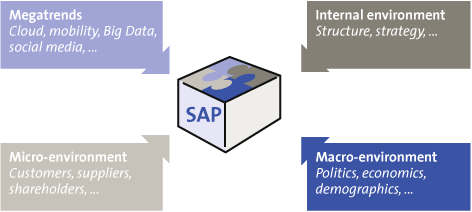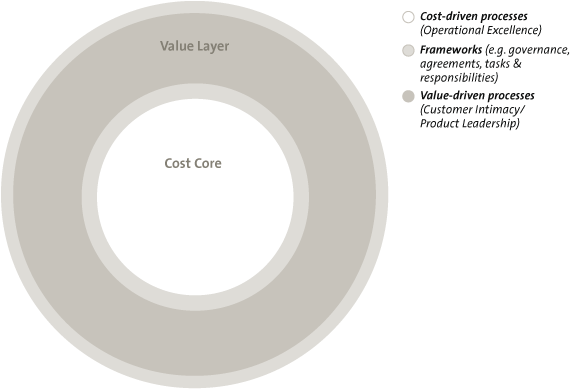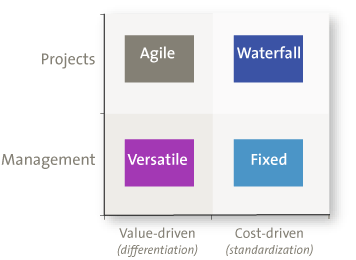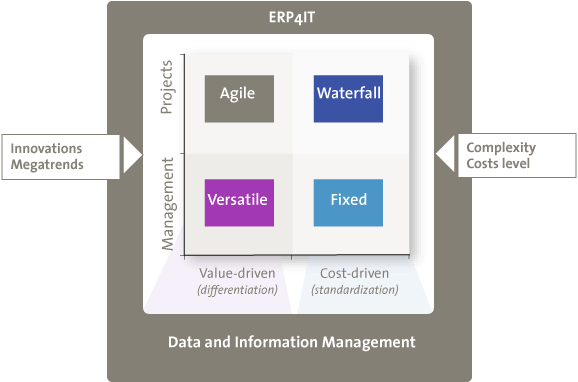The rate of renewal in and around the SAP domain is enormous, and is continuing to increase. Big Data, cloud, mobility and social media provide many new opportunities to create value for business. However, many IT organizations have had to work with tight budgets in an environment oriented toward cost reduction. Expectations are vast, but the resources (financial, human and knowledge) are limited, and the existing complexity is high. This article describes the challenges and priorities for SAP Competence Centers, including the added value of “ERP4IT” in the form of SAP Solution Manager.
Introduction
“Impossibilities we can do directly. Miracles take around two weeks.”
The marketing manager and the IT manager of an organization using SAP meet over coffee. The marketing manager has just come from the VNSG congress[Annual congress for all members of the Vereniging voor Nederlandstalige SAP Gebruikers (Association of Dutch-language SAP Users).] and is excited by a new development: “During the congress I saw a wonderful presentation on ‘SAP 360 Customer, powered by HANA’. It was fantastic seeing how we could communicate with all our customers in real time and obtain insight into their purchasing behavior and needs. We could react more quickly to changes in the market and, at the same time, leave a positive footprint in the world of social media. Can you arrange to obtain and implement that in around a month, so that we can start realizing its benefits?”
The response of the IT manager is predictable: “I know that system, and would dearly love to implement it, but unfortunately we won’t be able to create it in our current IT landscape. At this moment we are still extremely busy trying to integrate the IT environment of the company that we took over last year. We hope that we will be finished on time, because we now really have to install the adjustments for SEPA. As soon as we have finished that, we will have to deal with the annual patches for HR, and then we can start on a technical upgrade of the current SAP environment. If we do not go through a new restructuring next year, we might be able to start on SAP 360 Customer in about a year and a half.”
The challenges
“It is already difficult to keep up with the speed of change, never mind to get ahead of it.”
SAP Competence Centers (see the figure below) within organizations have the specific task of managing and renovating the technical and functional aspects of the existing SAP landscape. This entails, for example, maintaining reliable information provisioning, guaranteeing the availability of systems, implementing the necessary updates, patches and upgrades, resolving incidents and problems, and executing the functional changes required by the users. SAP Competence Centers deal with dynamics and complexities that are increasing due to the business’s growing expectations, the acceleration in technological developments, and the complexity of the current system landscape. In addition, there is always a continual flow of external and internal factors that keep the pressure on, such as new (international) markets, changing rules and regulations (such as Solvency II or SEPA requirements) and mergers and takeovers.
SAP Competence Center
Management, development and expertise of SAP systems is organized in many different ways within organizations. For example, there are differences between the degree of centralization (local clusters for SAP management versus central shared services) and the types of services (monitoring incidents and alterations, versus participating in strategic planning throughout the business). Even the names of the SAP service groups differ; they may be called SAP Shared Service Centers, SAP (Customer) Centers of Excellence, or SAP Centers of Expertise. In this article, we refer to all these manifestations as “SAP Competence Centers.” The SAP Competence Center may be an independent department or a part of an IT department with a wider focus than merely SAP.

Figure 1. Internal and external factors have an impact on the SAP landscape.
These developments demand (rapid) changes in the (SAP) landscape, while the need for maximum availability, stability and cost-efficiency of IT persists. Many SAP Competence Centers struggle with this dilemma on an everyday basis. A number of challenges facing SAP Competence Centers are further elaborated on the next page.
Expectations gap between demand and supply
Expectations with regard to IT have increased substantially over the past decade. Users expect that everything is available 24/7, that there is a mobile app for everything, that new possibilities become available within a few weeks at the most, and that they can plug into every conceivable device. They also feel entitled to well-protected data, stable applications and intuitive interfaces. SAP Competence Centers are faced with the challenge of responding to the requirements of the user, and this produces, almost by definition, a field of tension between the goals of the business (which wants to exploit changes in the outside world immediately) and the needs of the IT organization (which is required to ensure continuity, and therefore often applies the brakes in order to guarantee reliability and stability). This schism will only become greater in the coming years as a consequence of the pressure on IT costs and the decreasing availability of qualified and experienced resources ([Gart13a]). It is difficult for many SAP Competence Centers to determine the right priorities, or to determine how to deploy limited resources in order to realize the best possible business result through SAP.
Complexity of the current landscape
Many organizations are visibly struggling with the complexity and dynamics of their existing SAP-oriented landscape. Much complexity has evolved over the years as a result of custom-made functionality, complex data structures, new environments (CRM, BW, SRM), deviation from standard functionality, system integrations, system separations, and system consolidations. Much time and money has been invested in maintaining and improving existing functionality, whereas relatively little time and money has been devoted to value creation and innovation. Many organizations spend more than 50% of their IT budget on maintaining applications, while budgets simply remain at the same level or are even shrinking, and the amount of functionality is growing ([Gart13a]). Partly due to this complexity, many organizations are still spending a large part of their total IT budget on non-differentiating functionality (market standards). This is even leading to situations in which organizations are seriously questioning whether or not they might be better off replacing the old tangle of complexity and starting all over again with a re-implementation (with on-premise software, or perhaps in the cloud with SAP Business-By-Design, for example). A related problem is that it is difficult for a SAP Competence Center to gain knowledge and experience with new technology, as a result of limited time and resources, and thus becomes strongly dependent on external resources.
Megatrends
Research by KPMG ([Matu12]) on new disruptive technological innovations among 668 global technology leaders from ten of the most technologically innovative countries indicates which new technologies are regarded as “enablers” or “drivers” of business transformation. These can be grouped into four domains.
Cloud. Cloud is characterized by the fact that IT resources are divided as much as possible among several clients (hiring services on request). The services are provided via the internet, and the capacity can be increased or reduced at any time. To the SAP Competence Center, this means challenges with respect to information security, supply management and the integration of cloud and on-premise technology. In this context, please refer to “The art of inversion” below.
Social Media. Organizations can deploy social media to send information (organizational output) or to collect information from the environment (customer input). By networking through social media in this way, organizations can strengthen their reputation, enhance interaction with customers, investigate new methods of selling, and even innovate their business model ([Koot13]). Supporting social media entails new platforms and integrations that must be managed by the SAP Competence Center, including the corresponding requirements around information protection and privacy.
Mobility. Mobility is all about the deployment and use of mobile devices in business environments. New applications precisely for this purpose are realized in short cycles and tested in practice. Mobility puts greater pressure on SAP Competence Centers as a result of, for example (1) protection and privacy of data that becomes available on mobile devices, (2) management of the various mobile platforms and devices, and (3) new software and software development.
Big Data. Big Data has three major features: volume, speed and variation. Big Data brings new techniques that SAP Competence Centers must incorporate and manage within their existing landscape: (1) new techniques in order to process enormous data flows in real time, (2) new design choices and processing methods, (3) connections to other types of databases, and (4) a great variety of data types ([Amor12]).
Impact of innovative and changing technologies
An enormous acceleration in technological development is visible on various fronts (see Text box above). These developments are bringing hordes of innovative possibilities, as well as additional complexity around implementation, integration and management. This is having a major impact on SAP Competence Centers, not only due to the growing rate of change itself, but also due to the extension of the applications and infrastructure beyond the classical domains over which the SAP Competence Center exercises control (the on-premise SAP/ERP systems). SAP Competence Centers must cope with:
- new technology, such as Android and iOS in the context of apps and mobility
- new infrastructures, such as mobility platforms and HANA, for example
- new integrations, such as the SAP back-end, via satellite systems (such as CRM, SRM and BCM), to mobile devices and integration with the cloud
- new partners, such as suppliers of mobility platforms and cloud solutions.
Many Competence Centers have difficulty absorbing this. Additional expertise is necessary with regard to new technology, infrastructures, software and integrations. Due to their traditional focus on cost optimization and control ([Gart13a]), SAP Competence Centers have primarily configured their processes and structures for the purpose of maintaining and optimizing the existing situation. Other processes and structures for management and development are needed in order to keep pace with the speed of innovation in technology. Not only has a schism arisen between maintenance and innovation, but issues concerning chain management and developing an oversight or governing function have also become everyday occurrences. These themes are discussed further below in “The art of inversion.”
The art of inversion
The IT industry is currently moving in several different directions that are based on new technology, such as the trend toward SAP in the cloud. The fact that SAP systems operate somewhere in the cloud and are not hosted on the business’s own server is not so very relevant in itself, because it is essentially only a technical adaptation. But what is much more important is that possibilities are being created for approaching IT in a different way. IT applications from different organizations are increasingly forming an ecosystem in which various systems make use of one another’s data and functionality. LinkedIn is a good example of this. In the era prior to the advent of social media, professionals personally administered their address books with contacts. With the arrival of LinkedIn, the professionals have actually assigned the administration of their address book to their counterparts: if a contact switches jobs, the address book is automatically adjusted. The inversion of thinking – the maintenance of data at the source itself – is exercising influence all around, and is also reaching into SAP packages.
In system development, the challenge lies in ensuring that a package becomes a seamless component of an ecosystem of other systems and, as such, constructs interfaces by means of certified connections. The possibilities are then both endless and flexible. In this way, an organization never needs to adapt the article files of a supplier because the supplier does it himself. Moreover, he also offers an attractive interface for online ordering, which is directly linked to the systems of the customer organization itself. This all occurs out of sight of the user. A number of parties have made great leaps forward in this field and have also inverted the business model of the software. There is no longer mention of licenses. For example, the new parties are applying a model that is based upon a subscription system in which a fee is determined for every transaction.
It seems to be only a question of time before this type of development makes a major breakthrough. The shifts can be characterized as follows:
| Classical IT development | New IT development |
|---|---|
| Programmers and IT consultants dominate | Business and business partners dominate |
| Lengthy and expensive projects | Paid capitalization on new requirements through an open platform |
| Periodical replacement of packages | Continuous expansion of existing packages and addition of new applications |
| Thinking in terms of systems and modules | Thinking in terms of chains and added value |
| Reflection on the basis of one’s own systems | Reflection of the basis of ecosystem with business partners |
Priorities for SAP Competence Centers
Reduction of complexity and lowering of cost levels
The SAP Competence Center must prioritize reducing the effort (and the associated costs) needed to keep the existing landscape operational, so that it can have more resources available for technological innovations that enable an organization to distinguish itself on the market. This begins with reducing complexity. In this pursuit, the emphasis lies on cost-driven, non-differentiating processes. Complexity is not diminished in a single project. A continuous process (plan-do-check-act) is necessary for this, one in which the complexity is determined and eliminated iteratively.
The process begins with a determination of status, such as a so-called “SAP complexity assessment.”[For more details, see the article “A structured approach to reduce SAP complexity” in this issue of Compact.] This SAP complexity assessment comprises of three stages, namely, a quick scan to obtain insight into “Complexity Drivers”, analyses by means of, for example, Facts2Value® tooling to obtain factual insight into business and SAP complexity, and the formulation and implementation of a “Value Driven Complexity Roadmap” based on a valid business case. This SAP complexity assessment can be directed to the following fields, among others:
- Process standardization and harmonization. Is everyone using the system in the same way and as it was intended? Are there many (unnecessary) manual actions involved in the processes?
- Landscape optimization. Have standards been established for interfacing, enterprise architecture and master data management? Is the functionality being provided by the right applications?
- Reduction in customized output. Where does custom code / programs reside in the SAP system, what kind of impact is it having, and it is really necessary? Much custom code has become superfluous but is nevertheless retained because it is interwoven with other software.
- Hosting and housing. To what extent is the technical platform capable of fulfilling existing needs and benchmarks with regard to best practices? Are you providing the proper service levels for the business at the lowest possible price? Are you only paying for what you really need?
A differentiated operating model for SAP Competence Centers
A new vision on the existing processes and structures (the operating model) behind SAP Competence Centers is required in order to be able to cope with increasing complexity and rapid changes. Current processes and structures are mainly directed toward the maintenance and controlled renewal of SAP systems (in this context we can think of controlled but occasionally over-bureaucratic ITIL, ASL and BISL processes). A new operating model is required, oriented toward a strategy of innovation, versatility and network structures (inside and outside the organization). It is necessary to embrace rapid innovations and complexity while simultaneously keeping the stability and reliability of the IT environment as a whole at an adequate level. The new model is not a replacement of the old one; they complement one another. Nowadays, SAP Competence Centers can only be successful if they accept, implement and master both models. The one model is directed toward adaptive capability, speed and creativity, whereas the other one is oriented toward mastery, stability and control. A Competence Center must realize that these models have different orientations, a different style of governance and organization, other processes, other competences and different methods of performance assessment.
Accordingly, organizations should make a sharp analysis of their business operations (and, with this, their ERP systems and/or IT landscape in a broader sense) and make a clear distinction between two categories of processes, namely, cost-driven processes and value-driven processes.
The cost-driven processes – such as financial and personnel processes – are suited to stringent standardization with IT in a tight management organization. Operational excellence is key, and severe demands are made upon reliability and continuity. The projects and the management of these systems are classically structured, with the IT function taking precedence in matters such as budgets and governance.
Value-driven processes are concerned with rapid capitalization on opportunities in new markets, the rollout of new business models, the provision of new innovative solutions, or the capture of new sales outlets. In such fields, it is extremely important to allow for more freedom in the development and application of IT. In such systems, the focus lies on innovation (product leadership) and on the value for the client (customer intimacy) rather than on operational excellence. In these processes, businesses should be able to ally themselves with the clients and other parties in the external environment. This requires a flexible execution of projects and governance, where innovation and collaboration with the business are the central points of concern. In this category, it is the business that must take the lead with regard to matters such as budget and governance, rather than the IT function.
This does not mean, however, that absolute freedom must be allowed in the configuration of IT projects in the value-driven category. The success of allowing leeway actually depends on the fact that clear boundaries must be specified and consistently observed. The definition of this governance will have to be initiated by the IT function, but must be formulated in consultation with the users (business).
Application lifecycle
- Systems of ideation: new applications built on an ad hoc basis to address emerging business requirements and opportunities. These are typically short lifecycle projects (less than 12 months), using departmental or external resources and consumer-grade technologies.
- Systems of differentiation: applications that enable unique company processes or industry-specific capabilities. They have a medium lifecycle (one to three years), but need to be reconfigured frequently to accommodate changing business practices or customer requirements.
- Systems of record: established packaged applications or legacy homegrown systems that support core transaction processing and manage the organization’s critical master data. The rate of change is low, because the processes are well established, common to most organizations, and often subject to regulations or recommended practices.
Thus, there are two kinds of processes – cost-driven and value-driven – each of which deserves a unique approach. Around them, there are the frameworks needed to enable both approaches to function smoothly (see Figure 2). This links up with the application lifecycle that can be characterized by three “life stages” of applications:[Source: Gartner’s “pace-layered application strategy.” ] systems of ideation, systems of differentiation and systems of record (see on the left). An innovative application begins on the outer edge of the circle and moves toward the centre as it grows in the lifecycle.

Figure 2. A distinction between value-driven and cost-driven processes and IT functionality.
The impact on the IT function is very clear in the core. As soon as organizations understand what their cost-driven and their value-driven processes are, they can align their IT function to them. This distinction must be implemented in both the management and the development of IT. Figure 3 represents this situation in schematic terms.

Figure 3. The four quadrants of the IT function.
The quadrant in the upper right-hand corner covers the “classical” method of IT development, as often used in large-scale SAP projects in the past few years. This is certainly relevant where cost-driven processes are involved. They frequently concern large long-term projects whose aim is to realize a system that scores well in terms of efficiency, reliability and stability. The traditional “Waterfall” approach is and remains a useful approach. The quadrant in the lower right-hand corner describes the management of such systems. This activity is also classically configured (mainly according to ITIL and ASL) in order to guarantee continuity. Two of the most important tasks are the improvement of efficiency and the maintenance of systems such as the periodic installation of updates and the resolution of incidents and requests for change.
The left-hand side of the model shows the processes that are value-driven. These require a different style of IT development and management. Within IT projects this is known as “Agile” (such as SCRUM, for example), and with regard to management, we call this “Versatile”. With Agile and Versatile, all parties involved (developers, managers and the business) direct their efforts primarily to the continuous development of the most urgent functionality, to close collaboration, and to the production of directly usable functionality. These methods are based on small incremental returns with short-cycle planning. Feedback promotes further direct development. With regard to value-driven functionality, change requests from the business are quite considerable in the early stages of the application lifecycle. This volume of change requests stabilizes as soon as the functionality has become mature and shifts from the systems of differentiation to the systems of record. Until that time, the business will not accept that it has to wait six months (or longer, depending on the release calendar).
The advantage of such approaches over classical methods is that work is performed in set-ups that are less strictly structured in terms of phases, and that changing demands and requirements can be processed quickly. This places different demands on the competences of developers and managers. In this form of software development, the chance of disruption and the need for alteration are greater than in an approach attuned to the waterfall model. The consequence of this is that developers and managers cannot rely blindly on fixed procedures and updates, but must themselves be very critical in their view of risks.
The connections between value-driven and cost-driven processes (and the underlying functionality) form an area of concern. There is a need to standardize these connections in, for example, fixed and organization-wide data models, standard middleware technologies, standard protocols, and clear agreements between the world of standardization and the world of innovation.
Focus on data and information
The basic principles of ERP systems consist of (nearly) real-time end-to-end process automation, the integration of processes, and one database to support all these processes. A great advantage is that an ERP system connects all process data (transaction data) and makes it available for analysis. In addition, an ERP system realizes data consistency throughout all processes by configuring master data (such as customer data) that can work with both finance and sales. But if that data so influences the value of the system as a whole, why is it data so often of such low quality, and why do organizations have so much difficulty extracting reliable management information from their systems?
The answers to such questions are diverse and this article does not pretend to cover them in detail.[Consider articles on effective business intelligence and master data management, such as [Unen12] and [Grif12]. ] However, SAP Competence Centers must deal with this data problem. Many SAP Competence Centers have (master) data management and/or reporting teams and, as such, bear the responsibility for data management, data quality and the provision of information.
SAP Competence Centers must take the initiative to better organize data management and reporting. At doing this, they should align with the relevant process owners within the business. Clear data ownership on the part of Business Process Owners, controlled processes for data management and data quality monitoring are examples of elements that require attention. Improving the field of reporting, BI and performance management is an important area of concern for the coming years. The business will only demand more and more in the field of (real-time) information and analytics, partly due to the acceleration driven by SAP HANA.[For more details, please see the article “Creating Business Value with SAP HANA” in this issue of Compact. ]
ERP4IT as enabler
In the coming years, SAP Competence Centers will have to invest substantially in automating their own management processes. The automation of IT processes is also known as ERP4IT: the realization of integrated – and frequently automated – systems for IT processes such as change management, incident management, performance management and test management. ERP4IT automates and integrates these processes with one another and with the systems that are being managed. In this context, incident reports are becoming linked to underlying configuration details, for example, or process blueprints are being completely integrated with system data (configuration details, test scripts, definition of tailor-made work, etc.) and automated business process monitoring is being established. There is already a great deal of software available to support IT management processes, but the shift toward genuinely integrated ERP4IT has only just begun.
With the aid of ERP4IT, SAP Competence Centers can give due priority to lowering costs and to enhancing the quality of service provision and the SAP system (through reducing customization, business process analysis and performance analysis).
The following section presents an outline of SAP Solution Manager, which is positioned as the SAP module that supports the whole lifecycle of the SAP system. We examine ways in which an ERP4IT solution can offer support when a business confronts the challenges mentioned, including development in all four quadrants (Versatile, Agile, Waterfall, Fixed).
ERP4IT: SAP Solution Manager
By means of the System Landscape Product System (SLPS), SAP Solution Manager (SSM) makes it possible to clearly define and take inventory of the technical SAP landscape, as well as all systems and applications that form a part of it. Apart from this, there is the Business Process Repository (BPR), the functional heart in which the business scenarios and processes have been established up to transaction level. By ensuring a connection between the technical heart and the functional heart, an organization can obtain good insight into the systems and applications that are used for the various processes. SSM is a powerful resource to find out, at any given moment, just where renewal and maintenance are needed or are taking place, and the ways in which these are having an impact on processes and functionality. For example, SSM makes it possible to generate a process blueprint on the basis of the current SAP configuration (SoDocA), to monitor business processes on KPI’s real-time (Business Process Monitoring), to chart custom code (Custom Code Analyzer) and to support (data) transformations in the landscape (Landscape Transformation). SSM can be further understood with the help of the previously mentioned four areas of development and management.

Figure 4. A summary of the priorities of SAP Competence Centers.
For system development with regard to cost-driven processes (Waterfall), it is important to reduce complexity to a minimum and to work with standardized and transparent processes and IT. SSM offers out-of-the-box best practices for this purpose. SSM structures renewal, registers choices and knowledge and, in doing so, guarantees the controlled transition from development to management. For system development according to structured, schematic and standardized methodologies, SSM provides a standard project approach, as well as structures and templates for a variety of project types. These vary from a “greenfield” implementation to a rollout of a global SAP template to local organizations. SSM helps in the structured determination of a process hierarchy, process flows and other specific information related to system development, such as configuration material and test scripts, for example.
System development for value-driven processes (Agile) requires innovative, flexible, creative and rapid methodologies and, consequently, qualities other than those involved in conventional structured approaches. The speed is greater, and therefore flexibility must also increase because recalibrating the requirements is constantly taking place. There must be a simple, transparent process in which users are involved in every step. With its integrated roadmaps, SSM offers resources (so-called “accelerators”) to support this Agile way of system development. In this framework, we can think of specific tools, templates and methodological descriptions (such as a “sprint backlog” template, for example). The methodology contains iterative feedback loops, control points and visualizations. Visualization is an important instrument to realize functionality quickly and flexibly. Mock-ups sketch a picture of the user interface, but do not simulate interaction with the system. Prototypes give a picture of the user interface and the interaction, but creating them costs a lot of time and money. Specific technology for creating this visualization jointly with the business – and translating it into software – is rapidly gaining ground. As it does, IT can inspire the business and contribute to innovation. SSM and iRise offer these resources.
Classical application management for cost-driven processes (Fixed) is largely founded on ITIL, ASL and BiSL, among others, and has a high degree of standardization and optimization. SSM supports these processes. Formal procedures mitigate risks related to change, and a service desk registers all reports and links them to items from the SLPS and BPR. After these risks or flaws have been registered and classified, they are reviewed in the “incident,” “problem” and “change” steps of the process. This classical environment is also the basis of adequate release management for the entire landscape, and is described in the maintenance cycle in SSM. Changes only take place on the basis of (bi-)annual legal adjustments, or as a part of a major improvement project.
Application management on value-driven processes (Versatile) has a wholly different kind of dynamics. More innovation must be realized daily in order to capitalize on new technological possibilities and changing markets and customer requirements. This demands a flexible approach by the management. In SSM, extra maintenance cycles have been prescribed to dovetail with the dynamics of the processes that support functionality: fortnightly or monthly maintenance cycles and occasionally even a one-day cycle, where necessary. For these processes, urgent corrections are often the rule rather than the exception. For optimal functioning of these processes, it is important to ensure that the SLPS and BPR are (kept) up to date, to gain good insight into the IT landscape and the associated risks. Innovation means learning, and making mistakes is a part of learning. Versatile application management is not directed toward excluding all risks, but rather toward being able to deal effectively with them on the basis of sharp and up-to-date insight.
Conclusion
The pressure on SAP Competence Centers will continue to grow as a consequence of the high rate of technological renewals and innovations (largely beyond the classical ERP domain), the need of businesses to differentiate, the complexity in the current ERP landscape, organizational changes, and the continual focus on cost reduction.
SAP Competence Centers must determine their priorities by organizing themselves in a different way in order to cope with conservation, maintenance and renewal. In addition to adequate data and information management, tooling is also an important enabler to support integrated and automated IT processes. The Competence Center manager who formulates the right priorities and thus manages to handle the dynamic requirements of the business can enjoy a relaxed, well-earned cup of coffee. Whatever questions or problems the marketing manager has can be readily dealt with by the Competence Center.
References
[Amor12] J.M. Amoraal, F.M. Jansen, R.P.M. Logjes, S. van der Putten, M. Hoekstra, “#TheaterShooting: Applying Big Data Analytics to Social Media,” Compact 2012/4.
[Door12] P.R. van Doorn, R.P.M. Logjes, “Consumerization of IT: de veranderende verhouding tussen business en IT,” Compact 2012/3.
[Gart13a] CIO Agenda Insights 2013.
[Gart13b] Gartner Agenda Overview for Application Strategy and Governance 2013.
[Grif12] T.D. Griffioen, F. van der Waa, “Een gestructureerde aanpak voor de verbetering van business intelligence,” Compact, 2012/2.
[Koot13] W. Koot, Social media – Het speelkwartier is voorbij, KPMG 2013.
[Matu12] Matuszak et al., KPMG Technology Innovation Survey, 2012.
[Unen12] K. van Unen, A.S.M. de Goeij, S. Swartjes, A.J. van der Staaij, “Master Data Management: Dos & Don’ts,” Compact, 2012/2.





